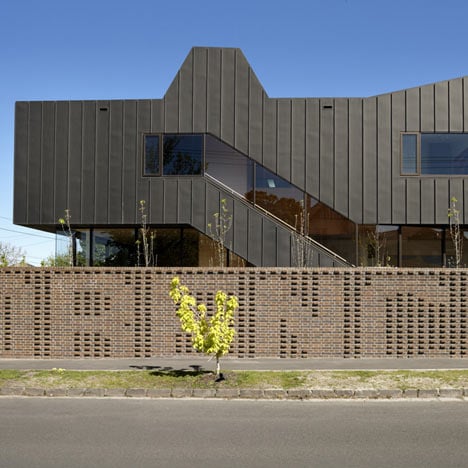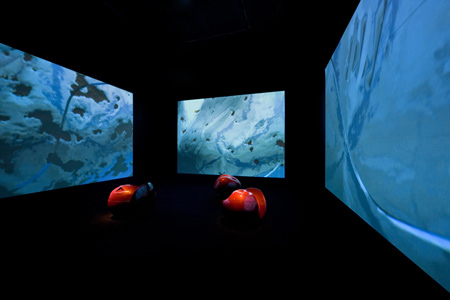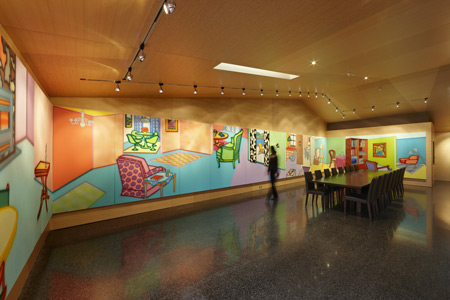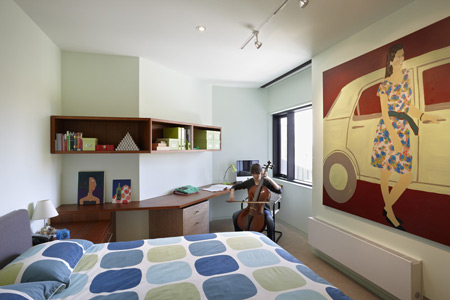
This building by Australian architects Lyons in Melbourne combines a family home with a museum.

Called Lyon Housemuseum, the project was built for the architects’ own family and their art collection.

It is open to the public weekly for tours and research visits, and also hosts a program of events.

The family’s kitchen doubles as a cafe and a room for video installations can be used as a home cinema.

Artworks are on display throughout the home and in two dedicated spaces, while certain rooms are enclosed and made private for the residents.

The names of the two streets on which the corner plot sits are emblazoned in two metre-high letters in brickwork on the boundary wall.

Photographs are by Dianna Snape.

Here are some more details from the architects:
LYON HOUSEMUSEUM
The Lyon Housemuseum speculates on the conjunction of art and living, on conventional notions of ‘public’ and ‘private’

and explores new relationships between art and architecture through the development of a new hybridised type – a ‘housemuseum’.
Drawing on historical precedents such as the Peggy Guggenheim Museum in Venice and John Soane’s Museum in London the Housemuseum displays art in a combination of museum and residential scaled spaces which are juxtaposed and intermixed.

Located in a suburb of Melbourne, Australia, the building accommodates the daily living needs of a family of four and the requirements of a fully functioning public museum housing a major collection of contemporary art.

The building is open weekly for public tours and for research visits by academics and students.

The Housemuseum also hosts an annual program of concerts, artist and architecture talks and other cultural events.

The juxtaposition of two seemingly conflicting programs presented unique opportunities and challenges for the design.

These were resolved not by demarking separate ‘private’ and ‘public’ zones but by juxtaposing and interweaving the two programs and types.

Spaces in the building are intentionally ambiguous in their typological readings – the family kitchen doubles as the museum café, the black box showing video art is also used as a home cinema and for family sleepovers.

The private study functions as a research library for visiting academics and students.

Internally, two large double height spaces – a ‘white cube’ and ‘black box’ – anchor the two ends of the building and are designed explicitly as public museum spaces.

Private spaces for the family, defined with enclosed boxlike forms, are dispersed across the two levels of the building.

Further spaces which are used by both family and visitors flow around and in between, creating scenographic spaces for the display of art.

These are interwoven with the domestic settings of the house.

Externally the building was conceived as a gable ended form (a primitive idea of ‘house’) which is extruded along the site as a long prismatic volume. A generous setback from Cotham Road and a re-entrant courtyard along the side street articulate the form through a series of volumetric shifts and deformations.
Click for larger image
Side gables, a truncated chimney and deep roof overhangs add ambiguity and complexity to the hybrid housemuseum form which is tightly wrapped in a skin of dark zinc.
Click for larger image
The building is contextualised within its suburban setting through use of corbelled brickwork on the street fences spelling out the names of the corner address – COTHAM and FLORENCE – in two metre high lettering.
Click for larger image
As an experimental and speculative project, the Housemuseum uses a new hybridised typology to explore relationships between public and private, ‘museum’ and ‘house’ and the interrelationship of art and living.
Click for larger image
Project Details:
Location: Kew, Melbourne
Size: 1100 m2
Architect: Lyons








所有评论